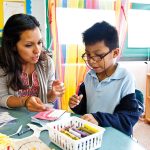Navigating the Spectrum: Understanding and Supporting Learning Difficulties and Disabilities

In the diverse tapestry of human cognition, learning difficulties and disabilities add unique threads, contributing to the rich fabric of individuality. While these challenges may present obstacles in traditional learning environments, understanding and addressing them is crucial for creating inclusive communities. In this blog post, we explore the spectrum of learning difficulties and disabilities, shedding light on the various facets and offering insights into how we can collectively foster a supportive and empowering educational landscape.
Unraveling the Spectrum:
1. Diverse Challenges, Unique Journeys:
- Learning difficulties encompass a broad spectrum of challenges, from dyslexia and dyscalculia to ADHD and sensory processing disorders.
- Each individual’s journey is unique, shaped by a combination of cognitive strengths and areas requiring additional support.
2. Beyond Labels: The Person, Not the Disability:
- It’s essential to recognize that a diagnosis does not define a person.
- Embracing a person-centered approach focuses on strengths, fostering a sense of identity beyond the constraints of labels.
Understanding Learning Difficulties:
1. Dyslexia: Decoding the Written Word:
- Dyslexia, often misunderstood, involves difficulties with reading, spelling, and writing.
- Early identification and personalized interventions can significantly improve literacy outcomes.
2. Dyscalculia: Navigating the World of Numbers:
- Challenges with mathematical concepts characterize dyscalculia.
- Multisensory approaches and real-world applications help individuals grasp mathematical principles.
3. ADHD: Harnessing Energy for Focus:
- Attention-Deficit/Hyperactivity Disorder (ADHD) presents challenges in attention, hyperactivity, and impulsivity.
- Structured routines, behavior interventions, and personalized learning strategies support academic success.
4. Sensory Processing Disorders: Navigating the Senses:
- Sensory processing disorders impact how individuals respond to sensory stimuli.
- Creating sensory-friendly environments and providing accommodations foster comfort and focus.
Nurturing Inclusive Learning Environments:
1. Embracing Universal Design for Learning (UDL):
- UDL principles ensure that educational materials and methods are accessible to all learners.
- Flexible assessments, varied teaching methods, and assistive technologies promote inclusivity.
2. Individualized Education Plans (IEPs):
- IEPs provide a roadmap for personalized learning, outlining specific goals and accommodations.
- Collaborative efforts involving educators, parents, and specialists are key to successful IEP implementation.
3. Cultivating Empathy and Understanding:
- Fostering a culture of empathy reduces stigma and encourages open dialogue.
- Awareness campaigns and education on learning difficulties contribute to a more compassionate community.
Real Stories of Triumph:
1. From Struggle to Strength: A Dyslexic Entrepreneur’s Journey:
- An inspiring narrative of an individual who turned challenges into strengths, emphasizing the importance of resilience and self-advocacy.
2. Inclusive Classrooms: A Teacher’s Impact on ADHD Success:
- A teacher’s innovative strategies and supportive approach that transformed a student’s academic experience with ADHD.
Looking Towards the Future:
1. Advocacy and Policy:
- Active advocacy for inclusive education policies that address the diverse needs of learners.
- Collaboration with policymakers to ensure the integration of evidence-based practices in educational settings.
2. Continued Research and Innovation:
- Ongoing research to understand the neurological and cognitive aspects of learning difficulties.
- Embracing technological innovations to enhance learning experiences and accessibility.
Conclusion:
Understanding and supporting individuals with learning difficulties and disabilities is not just a moral imperative; it is an investment in a more inclusive and diverse society. By acknowledging the spectrum of learning challenges, fostering empathy, and implementing evidence-based practices, we can create educational environments where every individual, regardless of their learning profile, can thrive. Let us collectively embark on a journey of empowerment, ensuring that every thread in the rich tapestry of human cognition is valued and woven into the fabric of inclusive education.











